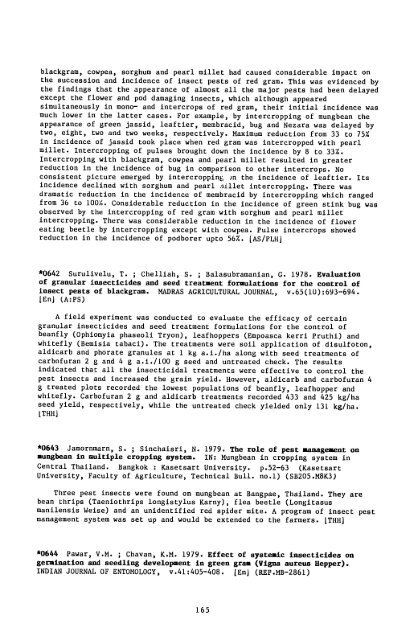PNABD246.pdf
PNABD246.pdf
PNABD246.pdf
Create successful ePaper yourself
Turn your PDF publications into a flip-book with our unique Google optimized e-Paper software.
lackgram, cowpea, sorghum and pearl millet had caused considerable impact on<br />
the succession and incidence of insect pests of red gram. This was evidenced by<br />
the findings that the appearance of almost all the major pests had been delayed<br />
except the flower and pod damaging insects, which although appeared<br />
simultaneously in mono- and intercrops of red gram, their initial incidence was<br />
much lower in the latter cases. For example, by intercropping of mungbean the<br />
appearance of green jassid, leaftier, membracid, bug and Nezara was delayed by<br />
two, eight, two and two weeks, respectively. Maximum reduction from 33 to 75%<br />
in incidence of jassid took place when red gram was intercropped with pearl<br />
millet. Intercropping of pulses brought down the incidence by 8 to 33%.<br />
Intercropping with blackgram, cowpea and pearl millet resulted in greater<br />
reduction in the incidence of bug in comparison to other intercrops. No<br />
consistent picture emerged by intercropping )n the incidence of leaftier. Its<br />
incidence declined with sorghum and pearl qillet intercropping. There was<br />
dramatic reduction in the incidence of membracid by intercropping which ranged<br />
from 36 to 100%. Considerable reduction in the incidence of green stink bug was<br />
observed by the intercropping of red gram with sorghum and pearl millet<br />
intercropping. There was considerable reduction in the incidence of flower<br />
eating beetle by intercropping except with cowpea. Pulse intercrops showed<br />
reduction in the incidence of podborer upto 56%. [AS/PLHJ<br />
*0642 Surulivelu, T. ; Chelliah, S. ; Balasubramanian, G. 1978. Evaluation<br />
of granular insecticides and seed treatment formulations for the control of<br />
insect pests of blackgram. MADRAS AGRICULTURAL JOURNAL, v.65(10):693-694.<br />
[En] (A:PS)<br />
A field experiment was conducted to evaluate the efficacy of certain<br />
granular insecticides and seed treatment formulations for the control of<br />
beanfly (Ophiomyia phaseoli Tryon), leafhoppers (Empoasca kerr Pruthi) and<br />
whitefly (Bemisia tabaci). The treatments were soil application of disulfoton,<br />
aldicarb and phorate granules at 1 kg a.i./ha along with seed treatments of<br />
carbofuran 2 g and 4 g a.i./100 g seed and untreated check. The results<br />
indicated that all the insecticidal treatments were effective to control the<br />
pest insects and increased the grain yield. However, aldicarb and carbofuran 4<br />
g treated plots recorded the lowest populations of beanfly, leafhopper and<br />
whitefly. Carbofuran 2 g and aldicarb treatments recorded 433 and 425 kg/ha<br />
seed yield, respectively, while the untreated check yielded only 131 kg/ha.<br />
[THHJ<br />
*0643 Jamornmarn, S. ; Sinchaisri, N. 1979. The role of pest management on<br />
mungbean in multiple cropping system. IN: Mungbean in cropping system in<br />
Central Thailand. Bangkok : Kasetsart University. p.52-63 (Kasetsart<br />
University, Faculty of Agriculture, Technical Bull. no.1) (SB205.M8K3)<br />
Three pest insects were found on mungbean at Bangpae, Thailand. They are<br />
bean thrips (Taeniothrips longistylus Karny), flea beetle (Longitasus<br />
manilensis Weise) and an unidentified red spider mite. A program of insect pest<br />
management system was set up and would be extended to the farmers. [THH]<br />
*0644 Pawar, V.M. ; Chavan, K.M. 1979. Effect of systemic insecticides on<br />
germination and seedling development in green gram (Vigna aureus Hepper).<br />
INDIAN JOURNAL OF ENTOMOLOGY, v.41:405-408. [En] (REP.MB-2861)<br />
165

















